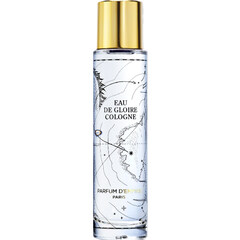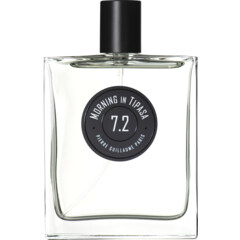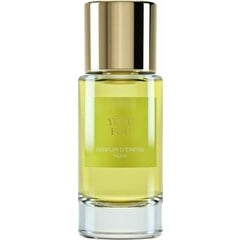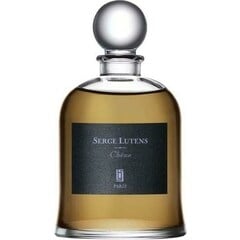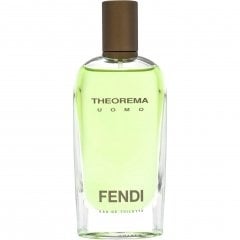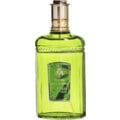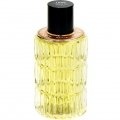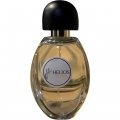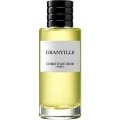
Intersport
Reviews
Filter & sort
Translated
Show original
Detour XV: Eaux de Gloire ..
Whoever says Eau de Gloire Cologne must also say Eau de Gloire, or vice versa, could that be the name of Parfum d'Empire HQ? But first things first - Eau de Gloire (2003) was Marc-Antoine Corticchiato's prelude to Parfum d'Empire. The fragrance was available as an eau de toilette for a long time before it was offered as an eau de parfum (2014) along with the majority of the range; for the company's 10th anniversary, there was a vintage edition designated as Cologne pour l'Hiver, and now, in 2023, for the 20th anniversary, Eau de Gloire Cologne. Originally, this version was to be released in the 'Napoleon year' 2022, but it also fits well in the following year.
Eau de Gloire - I could never tell the difference between the eau de toilette and the eau de parfum version - is one of Corticchiato's most classic works and has never been one of my favorites, or only partly, almost half and half, depending on your perspective: 50% of Eau de Gloire - the first half, so to speak - is to my liking, the remaining 50%, i.e. the finish, drydown, etc. less so or a little too dusty for me. The first part consists of a relaxed Mediterranean scrub accord, radiant in the evening sun; deeply aromatic, complex and polyphonic, citrus sparkles, immortelle here with light aniseed and tea-like shades, lavender, rosemary, cistus extract, herbal, refreshing and calming, all in all inviting, a very balanced and perfectly blended macchia cross-section. To fall in love with. So far so good: only this scene turns more and more into a full-blown leather chypre reminiscent of Hermès' Bel Ami (1986). Nothing reprehensible in itself, Bel Ami is one of the hits of the 80's, especially when it was still offered in the breathtakingly beautiful amber glass cocktail shaker with a Bakelite-like cap and, in matching colors, patterned cardboard packaging - one of the most coherent presentations of this decade, but never quite mine.
Admittedly, this duality suits Eau de Gloire, a fragrance that is also dedicated to Corticchiato's father, representative of all Corsicans (and Corsican women, although the Eau Suave (2005) was originally intended here?!) who had to emigrate in the 20th century to find social security elsewhere - a complex story, especially after the First World War, Corsica, its identity and the development of any infrastructure was consistently neglected by Paris. The reference to a leather chypre is perhaps fitting for these generations, as is the impression of a landscape, in the spirit of Bonaparte's bon mots, of being able to smell the island from the ship long before it appears on the horizon - a scene that even made it into an Asterix volume.
This is where Eau de Gloire Cologne and the power of dilution come into play. Not that Eau de Gloire Cologne is merely a lighter version of Eau de Gloire, no, I suspect this is more of a reconstruction, a re-engineering in which some ingredients have been replaced or renewed. I wouldn't be surprised if, as with the last Parfum d'Empire releases, the distillates used here were once again specially commissioned by the Acquarone family.
Similar to its predecessor, the cologne also plays with duality: here, an idiosyncratically bitter citrus note, slightly flavored by myrtle, at times with an orange tinge: Corticchiato can do citrusy things, Iskander (2006), Yuzu Fou (2008) and Azemour Les Orangers (2011) immediately come to mind, or more recently, the sophisticatedly clear Helios di Corsica (2018). The other half of the colognes consists largely of an upgrade of the aforementioned golden macchia accord. This is now also explicitly titled as such by the brand and not, as before, as a list of possible components. Certainly, the perfumer has rightly made a name for himself as a macchia expert over the years, and on top of that, these sparse, lush destinations are also becoming more and more 'en vogue' - in perfumes and elsewhere. Eau de Gloire is also exciting because it has anticipated many in-house trends. Even if my favorite macchia accord is probably hidden in the not-so-sounding Fougère Bengale (2007), the sequence from Eau de Gloire to Fougère Bengale to Tabac Tabou (2015) are stages of this development, before Corsica Furiosa (2014) and all the releases that have come under the Héritage Corse series lead far back to it. Like a prism, Héritage Corse refracted the Mediterranean light into a spectrum of meticulous studies of these terroirs, with more varied facets than just brown-gold.
Eau de Gloire Cologne follows on from this, the Bel Ami's melancholic foothills are now far dimmer, but not completely gone, the hesperidic aspects continue deep into the (short) course - and it seems as if the lighter construction, which also goes hand in hand with the cologne concentration in purely formal terms, almost intensifies the impression of a summer evening in the midst of aromatic undergrowth. If you ask perfumers why it is so difficult to depict real places, especially those in the open air, as fragrances, you always hear how microscopically small or low the ratios of measurable fragrance molecules to the surrounding volumes of air, space and atmosphere are. Less is more here, so to speak. Apart from the wonderful citrus start, it is perhaps what distinguishes Eau de Gloire Cologne, its dilution, the lingering in the implied, and the new interpretation of a whispered macchia accord. If you are looking for more aromatics and 'perfume' with leather-chypre references, you should confidently reach for the old Eau de Gloire, the lightweight version is no less exciting, different enough, and in its finer, modernized resolution also likeable. Bonne Anniversaire!
12 Comments
Translated
Show original
PG & SL à Tipasa
Albert Camus' essay 'Noces à Tipasa' (ca. 1936), Pierre Guillaume's inspiration for 7.2 Morning in Tipasa, provides a landscape portrait of the Algerian coastal town of Tipasa, complete with surrounding countryside, bursting with olfactory impressions. A text almost too inviting for a perfume. Right from the first page, there is talk of lush aromatic plants, the beguiling heat of the Algerian summer on the Mediterranean, before Camus gets specific: Bougainvilleas, hibiscus, tea-hybrid roses, irises, mastic trees, broom plants, geraniums, heliotrope, and again and again Artemisia absinthium: Wormwood, absinthe leaves. Always coastal breezes and sunshine. At least in the official notes there is none of that, mentioned here is: "Wild Lemongrass, Peppermint, Mediterranean Pine, Bergamot, Jujube Tree Honey". Lemongrass, presumably also wild, and jujube I would have guessed more from Malaysia eastwards, but in sum what Guillaume suggests here is coherent. Seaside coniferous, minty, herbal-aquatic start, followed by lots of pine and traces of honey, all in light.
I'm still not too familiar with the work of Michelin's original full-time chemist. That his production facility, like Michelin in the Auvergne, sits in Clermont-Ferrand, is sympathetic, the idea to subject own fragrances to an in-house remix also - the 7.2 in the title should refer to the predecessors 7.1 and 7. But I'm not sure how far this is still an in-house remix or already a style transfer. 7.2 Morning in Tipasa, reminds by the honey/pine combination - as already observed by AugustA - of Fille en Anguilles (2009), or rather of a finer, aquatic dilution of it. 'Mediterranean Pine Forest', much like Aquatic, is a perennial and unattainable fantasy of perfumers, fine as applied. I haven't been in Mediterranean pine forests for a while, but often in Atlantic ones, and every time I'm blown away by their complexity and lightness. In addition to the beach pines & co. that play a decisive role, it is also the sum of the other grasses, scrub, rocks and sediment that make up the whole. Lutens' coniferous forest is camp, it is clearly confessed perfume and not bottled landscape. Morning in Tipasa is also perfume, only the far more subtle dosage makes the difference here, mint and honey (Guillaume has already skillfully used in 25 Indochine) actually yield something that looks like slowly withering near the sea without drifting deep into the aquatic, here from the other side of the Mediterranean.
Approximately 810 km it is from Tipasa to the Corsican Scandola peninsula, as the crow flies. I have to think of their warm herbal aquatics distantly, 7.2 employs similar soft focus, though less differentiated. 3134 km, by car, via Paris, is the distance Tipasa -> Blenheim Castle. If the aforementioned soft focus or photographic bokeh were again overdriven by some amount, trace elements of the Paris - Edinburgh journey, which never quite arrived in Scotland, but at least at Bouquet Castle, would also be audible. And, to return to AugustA's aptly compact outline, this reduced, simpler volume suits the perfume quite well, a purposefully staged honeyed resinous pine, with minimal green-aquatic details.
I'm still not too familiar with the work of Michelin's original full-time chemist. That his production facility, like Michelin in the Auvergne, sits in Clermont-Ferrand, is sympathetic, the idea to subject own fragrances to an in-house remix also - the 7.2 in the title should refer to the predecessors 7.1 and 7. But I'm not sure how far this is still an in-house remix or already a style transfer. 7.2 Morning in Tipasa, reminds by the honey/pine combination - as already observed by AugustA - of Fille en Anguilles (2009), or rather of a finer, aquatic dilution of it. 'Mediterranean Pine Forest', much like Aquatic, is a perennial and unattainable fantasy of perfumers, fine as applied. I haven't been in Mediterranean pine forests for a while, but often in Atlantic ones, and every time I'm blown away by their complexity and lightness. In addition to the beach pines & co. that play a decisive role, it is also the sum of the other grasses, scrub, rocks and sediment that make up the whole. Lutens' coniferous forest is camp, it is clearly confessed perfume and not bottled landscape. Morning in Tipasa is also perfume, only the far more subtle dosage makes the difference here, mint and honey (Guillaume has already skillfully used in 25 Indochine) actually yield something that looks like slowly withering near the sea without drifting deep into the aquatic, here from the other side of the Mediterranean.
Approximately 810 km it is from Tipasa to the Corsican Scandola peninsula, as the crow flies. I have to think of their warm herbal aquatics distantly, 7.2 employs similar soft focus, though less differentiated. 3134 km, by car, via Paris, is the distance Tipasa -> Blenheim Castle. If the aforementioned soft focus or photographic bokeh were again overdriven by some amount, trace elements of the Paris - Edinburgh journey, which never quite arrived in Scotland, but at least at Bouquet Castle, would also be audible. And, to return to AugustA's aptly compact outline, this reduced, simpler volume suits the perfume quite well, a purposefully staged honeyed resinous pine, with minimal green-aquatic details.
8 Comments
Translated
Show original
Brix/acid ratio: 1.4-1.7
I have to revise my already once extended comment on Yuzu Fou from April 2021. For one thing, I have used the fragrance much more often since then than in years before, and in the course of this I also stumbled across Ayaka Uehara and Nicolas Baldovini's article "Volatile constituents of yuzu (Citrus junos Sieb. ex Tanaka) peel oil: A review" *. My original suspicion that Yuzu Fou could be a yuzu without yuzu has thus become unnecessary. My impression what for an exquisite citrus fragrance is here, once again confirmed.
"The great open air locations Anarlan's and SirLancelot's contributions to defy and yet precisely because of the thereby noticeably high humidity of summer Japan, I take refuge in the air-conditioned basements of the large department stores of the capital: Takashimaya, Matsuya, Itesan, Mitsukoshi. The 'food halls' set up there - pure understatement, it's more a mixture of jewelry store and delicatessen, are where I see Yuzu Fou. In the rows of these endless floors of specialized food, salesmen explaining with angelic patience the differences between various dried squids, miso or even yuzu products, elegantly ignoring the fact that you don't understand a word of Japanese, there are also always sections for 'gift fruits'. Here you can find single melons, framed with a gift ribbon, in a box in the exactly fitting ratio, which are then often in the three-digit euro range. If you want it even more luxurious, go to Senbikiya, the specialist among the specialists. I remember said melons, apples, and grapes. If a single yuzu fruit or just a shiso leaf would be here in such a gift box, it would be Yuzu Fou. Selected, thereby presented like high-class at one of the jewelers around the Place Vendôme.
To Yuzu I have in the first linie a gourmande connection. 20 years ago for the first time Japan, on the island of Kyushu in the restaurant that prepared EVERYTHING from the chicken, gave to the chicken soup Yuzu Kosho paste, which combines this fine citrus aroma with salt and chillies. A taste memory like the first shiso leaf. Since those days, I associate with yuzu, a delicate as cutting freshness, aromatics and high humidity. Yuzu Fou picks up here, but is also a possible blueprint for a construction style that was shifted into softer, spicier territory a few years later with Azemour. There are parallels especially in the development of the drydown. At the same time, the fragrance has a special, even exotic, super clear and subtle citrus aroma at the start, with mint clearly heading towards Shiso, much more polyphonic than Comme des Garçons unfortunately discontinued Series 1: Leaves - Shiso (2000). Perhaps the whole thing is a kind of Japonism, bringing this Far Eastern fruit into a French context with minimal chypre framing and verbena. Yuzu You oscillates between light and solid, much like the special structural engineering of Jun Sato & Co. that underlies the work of Junya Ishigami or S A N A A."
* Uehara, A. and Baldovini, N., 2021. volatile constituents of yuzu (Citrus junos Sieb. ex Tanaka) peel oil: A review. Flavour and Fragrance Journal, 36(2), pp.292-318.
"The great open air locations Anarlan's and SirLancelot's contributions to defy and yet precisely because of the thereby noticeably high humidity of summer Japan, I take refuge in the air-conditioned basements of the large department stores of the capital: Takashimaya, Matsuya, Itesan, Mitsukoshi. The 'food halls' set up there - pure understatement, it's more a mixture of jewelry store and delicatessen, are where I see Yuzu Fou. In the rows of these endless floors of specialized food, salesmen explaining with angelic patience the differences between various dried squids, miso or even yuzu products, elegantly ignoring the fact that you don't understand a word of Japanese, there are also always sections for 'gift fruits'. Here you can find single melons, framed with a gift ribbon, in a box in the exactly fitting ratio, which are then often in the three-digit euro range. If you want it even more luxurious, go to Senbikiya, the specialist among the specialists. I remember said melons, apples, and grapes. If a single yuzu fruit or just a shiso leaf would be here in such a gift box, it would be Yuzu Fou. Selected, thereby presented like high-class at one of the jewelers around the Place Vendôme.
To Yuzu I have in the first linie a gourmande connection. 20 years ago for the first time Japan, on the island of Kyushu in the restaurant that prepared EVERYTHING from the chicken, gave to the chicken soup Yuzu Kosho paste, which combines this fine citrus aroma with salt and chillies. A taste memory like the first shiso leaf. Since those days, I associate with yuzu, a delicate as cutting freshness, aromatics and high humidity. Yuzu Fou picks up here, but is also a possible blueprint for a construction style that was shifted into softer, spicier territory a few years later with Azemour. There are parallels especially in the development of the drydown. At the same time, the fragrance has a special, even exotic, super clear and subtle citrus aroma at the start, with mint clearly heading towards Shiso, much more polyphonic than Comme des Garçons unfortunately discontinued Series 1: Leaves - Shiso (2000). Perhaps the whole thing is a kind of Japonism, bringing this Far Eastern fruit into a French context with minimal chypre framing and verbena. Yuzu You oscillates between light and solid, much like the special structural engineering of Jun Sato & Co. that underlies the work of Junya Ishigami or S A N A A."
* Uehara, A. and Baldovini, N., 2021. volatile constituents of yuzu (Citrus junos Sieb. ex Tanaka) peel oil: A review. Flavour and Fragrance Journal, 36(2), pp.292-318.
3 Comments
Translated
Show original
Detour VII
§1 Woodways, xth, edition
The perfume - from the last 30 years - that keeps appearing in the 'oh, I would have liked to have designed that too' category by other perfumers, like brands, is Shiseido's Féminité du Bois.So the Humiecki's, supposedly Mr Mallé too - I like to think, was Pierre Bourdon, who occupies a sort of mentor role in Malle's cosmology, involved in the fragrance. Féminité du Bois, the stepping stone to Luten's universe in the 90's, and the official re-entry of wood in the title. True, there had been dozens of 'bois' perfumes for more than half a century before that, including an early one from Shiseido, but after Féminité du Bois, the 'bois' or 'du bois' wood glut was unstoppable.
There are many stories surrounding the origins of fragrance; why Bourdon was quickly replaced by Sheldrake; there is quantified balancing what percentage of which aroma chemical is the crux of the pudding, and so on. Féminité du Bois was a solitaire. So first of all, nothing smelled with comparable international distribution. The bottle and packaging were of exquisite beauty, a textured cardboard box, the colour palette matched to the bottle in every detail, this in turn in various, 'organic' shapes and concentrations. It had been a long time since a bottle had felt so good in the hand, and a long time since anything had smelled so fragile, delicate, distinctive and clear. In addition to the Shiseido fragrance, Lutens released a whole series of other closely related 'Bois' fragrances under his Palais Royal HQ in Paris: Bois de violette, Bois oriental, Bois et fruits. More than 10 years later, more 'Bois'. The wood perceived in these is said to be indebted to the cedar of Moroccan interiors. But cedar is also a note that exceeds even the stately number of 'bois' titled perfumes listed here many times over.
§2 Chêne
There's a small workshop in my street, more of a 'hole in the wall' at first impression - possibly a former warehouse, set right into the wall, where day in and day out, two gentlemen restore heavy wooden furniture. The workshop is tiny, there are no windows, one can probably only work with the door open, pieces of furniture that need to dry are pragmatically placed in a driveway on the opposite side of the street. There is no planing or carpentry in this workshop, the focus is on glazing, varnishing, painting, touching up. And that brings us to Chêne.
Aside from a few hits in the 90s, Lutens had a good drive in the early to mid 2000s. The subject matter shifted to French, or to repercussions of 'exotic' ingredients in French climes (so Bornéo 1834). Chêne, Oak, one of the releases from these years is perhaps one of the most impressive woody fragrances of the last 20 years. Chêne is very much about oak. Oak wood when it is cut up in a furniture maker's workshop, oak wood when it receives a fresh cell treatment in just such a workshop after decades or more. Chêne is also a good example of the wood polish chord I appreciate. Poliboy et. al, by a good dose of Lutens' beeswax. Chêne is also, however, and hence this detour, another Lutens with immortelle focus, not listed, but helichrysium or a fragrance with clearest immortelle descriptor could pull the strings here. But the framing always remains the oak, perhaps through an oak CO2 extract that may also have dried fruit, rum, and whiskey characteristics - much of which also plays a role in Chêne.
Chêne's shelf life is impressive; that it was only sold in 75ml and 50ml makes sense. The esteemed Gold mentions a 2018 book in her review of Bourreau des Fleurs in which Chêne is credited with a lengthy creation period of about 12 years. Be that as it may, the scent also makes me think of matured oak barrels and their contents, and in the multitude of sometimes worse sometimes better Lutens, for me the special reserve. The spirit of Chêne appeared together with a residual dose of Chypre Rouge last again in Participe Passé, but so dry, woody and Immortelle intertwined, smells only Chêne.
The perfume - from the last 30 years - that keeps appearing in the 'oh, I would have liked to have designed that too' category by other perfumers, like brands, is Shiseido's Féminité du Bois.So the Humiecki's, supposedly Mr Mallé too - I like to think, was Pierre Bourdon, who occupies a sort of mentor role in Malle's cosmology, involved in the fragrance. Féminité du Bois, the stepping stone to Luten's universe in the 90's, and the official re-entry of wood in the title. True, there had been dozens of 'bois' perfumes for more than half a century before that, including an early one from Shiseido, but after Féminité du Bois, the 'bois' or 'du bois' wood glut was unstoppable.
There are many stories surrounding the origins of fragrance; why Bourdon was quickly replaced by Sheldrake; there is quantified balancing what percentage of which aroma chemical is the crux of the pudding, and so on. Féminité du Bois was a solitaire. So first of all, nothing smelled with comparable international distribution. The bottle and packaging were of exquisite beauty, a textured cardboard box, the colour palette matched to the bottle in every detail, this in turn in various, 'organic' shapes and concentrations. It had been a long time since a bottle had felt so good in the hand, and a long time since anything had smelled so fragile, delicate, distinctive and clear. In addition to the Shiseido fragrance, Lutens released a whole series of other closely related 'Bois' fragrances under his Palais Royal HQ in Paris: Bois de violette, Bois oriental, Bois et fruits. More than 10 years later, more 'Bois'. The wood perceived in these is said to be indebted to the cedar of Moroccan interiors. But cedar is also a note that exceeds even the stately number of 'bois' titled perfumes listed here many times over.
§2 Chêne
There's a small workshop in my street, more of a 'hole in the wall' at first impression - possibly a former warehouse, set right into the wall, where day in and day out, two gentlemen restore heavy wooden furniture. The workshop is tiny, there are no windows, one can probably only work with the door open, pieces of furniture that need to dry are pragmatically placed in a driveway on the opposite side of the street. There is no planing or carpentry in this workshop, the focus is on glazing, varnishing, painting, touching up. And that brings us to Chêne.
Aside from a few hits in the 90s, Lutens had a good drive in the early to mid 2000s. The subject matter shifted to French, or to repercussions of 'exotic' ingredients in French climes (so Bornéo 1834). Chêne, Oak, one of the releases from these years is perhaps one of the most impressive woody fragrances of the last 20 years. Chêne is very much about oak. Oak wood when it is cut up in a furniture maker's workshop, oak wood when it receives a fresh cell treatment in just such a workshop after decades or more. Chêne is also a good example of the wood polish chord I appreciate. Poliboy et. al, by a good dose of Lutens' beeswax. Chêne is also, however, and hence this detour, another Lutens with immortelle focus, not listed, but helichrysium or a fragrance with clearest immortelle descriptor could pull the strings here. But the framing always remains the oak, perhaps through an oak CO2 extract that may also have dried fruit, rum, and whiskey characteristics - much of which also plays a role in Chêne.
Chêne's shelf life is impressive; that it was only sold in 75ml and 50ml makes sense. The esteemed Gold mentions a 2018 book in her review of Bourreau des Fleurs in which Chêne is credited with a lengthy creation period of about 12 years. Be that as it may, the scent also makes me think of matured oak barrels and their contents, and in the multitude of sometimes worse sometimes better Lutens, for me the special reserve. The spirit of Chêne appeared together with a residual dose of Chypre Rouge last again in Participe Passé, but so dry, woody and Immortelle intertwined, smells only Chêne.
7 Comments
Translated
Show original
Maximum difference
... or so Fendi's letter to Jacques Cavallier could have sounded. Maximum difference to Fendi Uomo from 1988, the balmy, almost cinnamon-gourmand late-80s first work of the company, an Italo-Antaeus or Mediterranean Bel Ami, including ads campaign in front of Roman antiquity in Renaissance pose, part photographed by Lagerfeld.
And the difference could hardly have been greater. Cavallier, mentioned for some time only under the double name Cavallier-Belletrud, was involved in the 90s in a variety of most diverse as successful alley hit. Perhaps Fendi simply wanted an eau à la Issey. But Cavallier's result is one of the lightest, most sheer and green organza fabrics I've come across. Other fragrances, especially from the designer sector of the time, seem like the heaviest whale loden against it, Comme des Garçons Series 1: Leaves comes close to Theorema Uomo, a few of Guerlain's Allegorias too, later some of Ellenaschen's Hermessences, but the Fendi remains more conventional perfume than reduced-skilled staging of ingredients. Theorema is once perfumed cut meadow grass, or its industrialized counterpart, sans plastic note in a lightly aquatic mist of geranium, mint, vetiver, bergamot, nutmeg and cardamom. The oscillation is successful, the perfume seems artificial and interwoven enough not to hallucinate only impressionistic gardener's constructs; to make out the presumed notes is difficult if you would increase the potencies by a factor of ten, maybe you will end up near Geranium pour Monsieur's mint-geranium-musk trio at some point. Theorema remains synthetic and ultra-light. Werner Sobek writes "Designing in lightweight construction is the search for the lightest possible ... reduction to a minimum previously thought inconceivable ...". Theorema Uomo is not even minimal, in the sense that it focuses on a reduction of one, two, three ingredients, it seems it is a broad spray, diffuse, temporary, ephemeral, lightweight construction, but voluminous and yet in slimmed down 90s outfit. Outlines of a facade behind wisps of fog, somewhere in the Po plain, or in Milan's suburbs. Melancholic? Perhaps the Fendi was too much, too much a water past which sailed a whole armada of greenest ingredients and, thanks to sufficient osmosis an impressively volatile eau has emerged.
Theorema Uomo comes in light green liquid, it could not fit better, in a functional-looking bottle, reduced, if you think of Uomo's meticulous Terrazzo Gold Monstrance. Whether the fascinating name now also has something to do with Pasolini's 1968'er film of the same name, Teorema - without 'h' - is not yet clear to me, particularly beguiling Theorema is not. The more voluptuous ladies version of Theorema from 1998 or the Fendi's of the 80's perhaps had more to do with this bourgeoisie.
And the difference could hardly have been greater. Cavallier, mentioned for some time only under the double name Cavallier-Belletrud, was involved in the 90s in a variety of most diverse as successful alley hit. Perhaps Fendi simply wanted an eau à la Issey. But Cavallier's result is one of the lightest, most sheer and green organza fabrics I've come across. Other fragrances, especially from the designer sector of the time, seem like the heaviest whale loden against it, Comme des Garçons Series 1: Leaves comes close to Theorema Uomo, a few of Guerlain's Allegorias too, later some of Ellenaschen's Hermessences, but the Fendi remains more conventional perfume than reduced-skilled staging of ingredients. Theorema is once perfumed cut meadow grass, or its industrialized counterpart, sans plastic note in a lightly aquatic mist of geranium, mint, vetiver, bergamot, nutmeg and cardamom. The oscillation is successful, the perfume seems artificial and interwoven enough not to hallucinate only impressionistic gardener's constructs; to make out the presumed notes is difficult if you would increase the potencies by a factor of ten, maybe you will end up near Geranium pour Monsieur's mint-geranium-musk trio at some point. Theorema remains synthetic and ultra-light. Werner Sobek writes "Designing in lightweight construction is the search for the lightest possible ... reduction to a minimum previously thought inconceivable ...". Theorema Uomo is not even minimal, in the sense that it focuses on a reduction of one, two, three ingredients, it seems it is a broad spray, diffuse, temporary, ephemeral, lightweight construction, but voluminous and yet in slimmed down 90s outfit. Outlines of a facade behind wisps of fog, somewhere in the Po plain, or in Milan's suburbs. Melancholic? Perhaps the Fendi was too much, too much a water past which sailed a whole armada of greenest ingredients and, thanks to sufficient osmosis an impressively volatile eau has emerged.
Theorema Uomo comes in light green liquid, it could not fit better, in a functional-looking bottle, reduced, if you think of Uomo's meticulous Terrazzo Gold Monstrance. Whether the fascinating name now also has something to do with Pasolini's 1968'er film of the same name, Teorema - without 'h' - is not yet clear to me, particularly beguiling Theorema is not. The more voluptuous ladies version of Theorema from 1998 or the Fendi's of the 80's perhaps had more to do with this bourgeoisie.
4 Comments

 Intersport
Intersport